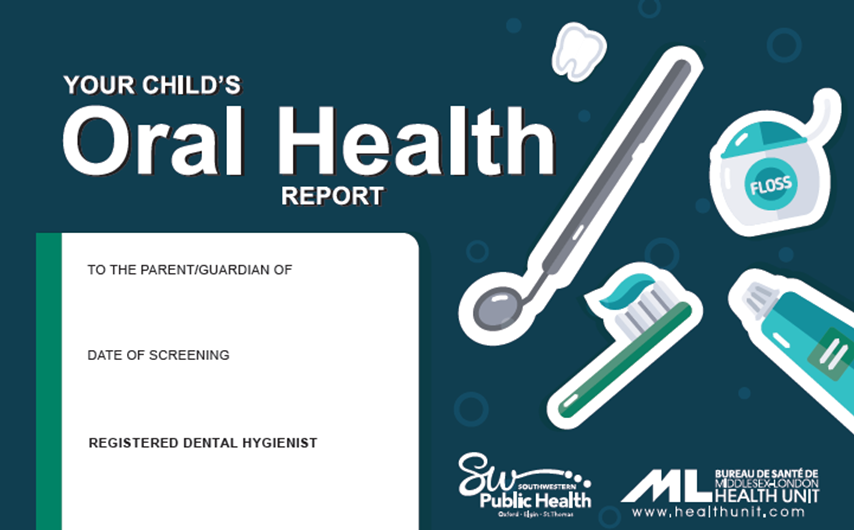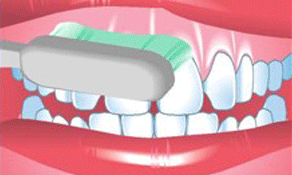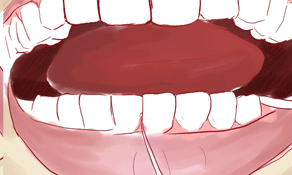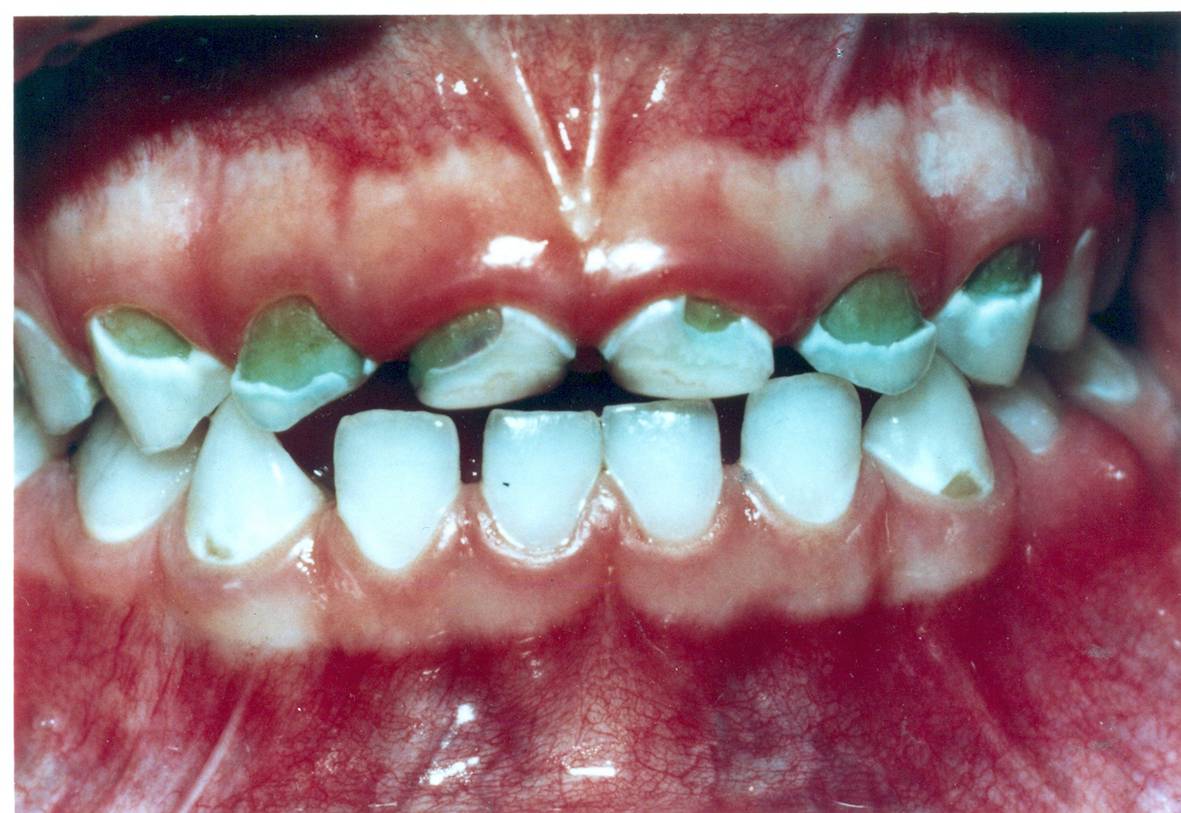
Children and Youth 0-17
First Dental Visit
Children should have their first visit to the dentist when they are one year old.
What will happen at my child’s first visit to the dentist?
The dentist or dental hygienist may:
- Ask about your child’s general health and growth
- Look inside your child’s mouth, while you hold your child
- Discuss how to care for your infant and toddler’s mouth and show you how to ‘lift the lip’ to look at your child’s mouth
- Ask about habits such as finger and thumb sucking and your child’s use of baby bottles, sippy cups and soothers
- Discuss the link between diet and dental health
The best way to prevent early problems with your child’s teeth is to find out your child’s risk of developing cavities. The Middlesex-London Health Unit offers a preventive program for your child’s teeth called PREV-OH (Preventive Oral Health). This program is located at the Middlesex-London Health Unit Dental Clinic at no cost for children who are 0 to 17 years of age.
Please call to book an appointment at 519-663-5317 (ask to speak with Oral Health)
Fluoride Varnish Program
Dental cavities are one of the most prevalent chronic diseases in people, affecting more than 57% of Canadian children. Apart from weakening the tooth, cavities can also lead to infection, pain, abscesses, difficulty with chewing and/or sleeping, poor nutrition and tooth loss.
The Middlesex-London Health Unit’s Fluoride Varnish Program helps to prevent tooth decay and other chronic diseases.
Partnering with various childcare centres, the MLHU is able to provide fluoride varnish free of charge.
What is fluoride varnish?
Fluoride varnish is a protective coating that makes teeth stronger, and helps prevent and fix small cavities. It is a liquid that is painted onto a child’s teeth with a small brush. It only takes minutes to apply and dries quickly.
Is it safe?
Yes. Fluoride varnish is safe and causes no harm. There is no bad taste and no pain or discomfort with the application. There may be a slight off-white colour to the teeth after the fluoride varnish is applied, but it will be removed by brushing or flossing, which can be done the morning after the application.
If you have questions, please contact the Oral Health and Clinical Support Services Team at 519-663-5317 (ask to speak with Oral Health).
School-based Screening
The Oral Health and Clinical Support Services Team at the Middlesex-London Health is mandated to provide dental screenings for all publically-funded elementary schools in the City of London and Middlesex County.
What is a dental screening?
A dental screening is a quick visual look in a child’s mouth using a “No Touch” technique. The dental screening is completed by a Registered Dental Hygienist with the help of a Certified Dental Assistant. The dental hygienist uses a sterilized mirror to move the cheek or tongue aside to see the teeth surfaces. Dental Report Cards are sent home with children who are screened to provide parents with feedback on their oral health. Please note: A dental screening does not replace an exam with a dentist.

Why did I receive a Parent Notification Form (PNF)?
Your child received a PNF because the dental hygienist found an urgent dental condition in your child’s mouth. The Health Unit is mandated to follow up on all urgent dental conditions and assist parents in seeking professional dental care. Please respond to the PNF you receive from the Health Unit regarding your child’s dental screening. If you have any questions about the PNF, please contact the Health Unit at 519-663-5317.
If your child is already enrolled in Healthy Smiles Ontario, you are able to pay for treatment and/or you have dental insurance: Ask your dentist to complete Sections 1 of the PNF and return to the Health Unit.
If you have no dental insurance, or other coverage, for the necessary treatment AND the cost of dental treatment is difficult: Complete Section 2A, 2B, 2C, 2D and 2E of the PNF. Your child may be eligible to receive the necessary treatment at no cost through the Healthy Smiles Ontario program.
What if I do not wish my child to be screened?
If you do not wish to have your child screened at school, please contact your child’s school to inquire about excluding your child from dental screening. If you have questions about your child’s dental screening, please call the Health Unit at 519-663-5317.
Healthy Smiles Ontario
Healthy Smiles Ontario (HSO) is a government-funded dental program that provides free preventive, routine, and emergency dental services for children and youth 17 years old and under from low-income households. The services covered by this program may include: exams and routine checkups, preventive services, removal of teeth, fillings, and x-rays. Cosmetic dentistry and braces are not covered by this program.
There are three streams to HSO:
HSO-Core
HSO-Core is an income-based dental program that provides routine dental services for eligible children.
Children are automatically enrolled in the program if they are enrolled in:
- Temporary Care Assistance
- Assistance for Children with Severe Disabilities
- Ontario Works
- Ontario Disability Support
Eligibility Criteria:
- Children and youth 17 years of age and under
- Resident of Ontario
- Have a household income below a specific threshold
How to Enroll:
- Call the Middlesex-London Health Unit to book an appointment at 519-663-5317 (ask to speak with Oral Health)
- Online at Healthy Smiles Ontario
- Call Service Ontario at 1-844-296-6306 (TTY toll-free at 1-800-387-5559)
HSO - Emergency and Essential Services (HSO-EESS)
HSO-EESS provides no cost dental care to children and youth 17 years of age and younger who qualify. The services covered by this program may include: exams, removal of teeth, fillings, and preventive services.
Eligibility Criteria:
- Children and youth 17 years of age and under
- Resident of Ontario
- Clinical eligibility
- Financial hardship accessing dental services
How to Enroll:
- Call the Middlesex-London Health Unit to book an appointment at 519-663-5317 (ask to speak with Oral Health)
HSO - Preventive Services Only (HSO-PSO)
HSO-PSO provides no cost preventive services to children and youth 17 years of age and younger who qualify. The services covered by this program may include: cleaning and polishing teeth, fluoride treatments, dental sealants, and temporary fillings.
Eligibility Criteria:
- Children and youth 17 years of age and under
- Resident of Ontario
- Clinical eligibility
- Financial hardship accessing dental services
- Does not have private dental insurance
How to Enroll:
- Call the Middlesex-London Health Unit to book an appointment at 519-663-5317 (ask to speak with Oral Health)
Caring for Your Teeth
The most important part of dental care happens at home. Brushing and flossing every day, along with regular dental checkups, can help prevent cavities and gum disease.
Brushing
Brush your teeth for two minutes, twice a day to help prevent cavities and gum disease. Plaque is an invisible film that develops on your teeth every day. Try to brush in the morning, before bedtime and when possible after meal.
How to Brush:
Adult and Youth Brushing Technique

Brush at a 45-degree angle to your teeth. Direct the bristles to where your gums and teeth meet. Use a gentle, circular, massaging motion, up and down. Do not scrub. Gums that recede are often a result of years of brushing too hard.

Clean every surface of every tooth including the chewing surface, the cheek side, and the tongue side.

Do not rush your brush. Brushing should take at least two minutes. Try timing yourself. Use a soft brush with rounded bristles. There are many different types of brushes, ask your dentist or dental hygienist to suggest the best one for you.
Flossing
Flossing removes plaque and germs that you cannot reach with your toothbrush. Plaque is the main cause of gum disease. It is an invisible film that develops on your teeth every day. Within 24 to 36 hours, plaque hardens into tartar, which can only be removed by having a professional cleaning. Gums sometimes bleed when you first begin to floss. Bleeding usually stops after a few days. If bleeding does not stop, see your dentist. Floss once a day.
How to Floss:

Gently slide the floss between your teeth.

Move the floss gently in a "C" motion when it makes contact with the gums and use a gentle up and down motion to clean the area.

Repeat the process between each tooth.

Don't forget the backs of your molars.

Rinse your mouth out with mouthwash or water when you're done flossing.
Babies
Healthy teeth and gums are important as your child grows, in order to help them speak well and eat healthy.
Without proper care of your child’s teeth, what could happen?
- Cavities and gum disease
- Infection
- Poor nutrition
- Lack of sleep
- Future serious dental problems
- Difficulty learning and talking
- Pain
Starting good oral hygiene habits from the beginning is important.
Before your baby’s first teeth come in:
- Wipe the gums off with a gauze or clean, wet washcloth.
- Wipe baby’s gums daily after feedings.
When your baby has teeth:
- Brush baby’s teeth with a soft, infant sized toothbrush.
- Brush baby’s teeth at least twice a day (bedtime is especially important).
- The easiest way to hold your baby while you clean their teeth is to sit down with the baby’s head in your lap.
- Do not use a fluoridated toothpaste until your child can spit and rinse.
Children
Good habits started in childhood can last a lifetime. Plaque is the soft, sticky film of bacteria and leftover food that stay on the teeth after eating. Plaque should be removed from the teeth to stop cavities and gum infections. If the plaque is left on the teeth it hardens and becomes tartar. Tarter needs to be removed by a dental professional. Children can develop tartar on their teeth the same way that adults can.
Encourage your child to:
- Use only a green pea-sized amount of fluoridated toothpaste for toothbrushing once the child can spit and rinse.
- Brush for two minutes, two times each day (morning and before bed)
- Floss once a day
Note: Children should have help brushing until the age of 7 years old. For more help on brushing and flossing visit the steps above.
Cavities


Cavities or tooth decay can affect toddlers and young children.
Early Childhood Tooth Decay (ECTD) is a severe kind of decay or cavity that affects the baby teeth, especially the upper front teeth. It is caused when leftover food including milk, juice, and breastmilk is not removed from the teeth. The sugars in these foods combines with bacteria in the mouth to make an acid which softens the teeth.
How can cavities and Early Childhood Tooth Decay be prevented?
- Limit foods and drinks with sugar
- Except at meals and snack times, bottles and sippy cups should only contain water
- Avoid putting your child to bed with a bottle of milk or juice
- Clean your child’s mouth after each feeding by wiping gums with a clean wash cloth
- As soon as your child has teeth, clean the teeth twice a day (morning and before bed) with a small, soft toothbrush and water, or non-fluoride toothpaste
- Soothers should not be dipped in honey or other sweeteners
- Lift your child’s lip once a month to check teeth and gums. If you see any chalky, white or brown spots on the teeth, take your child to see a dentist
- Children’s medications and chewable vitamins often contain sugar. Have your child rinse with water after taking them, and consider buying sugar-free formulas if available.
As soon as your child has teeth, clean the teeth twice a day, (morning and before bed).
References
http://www.cda-adc.ca/en/oral_health/cfyt/dental_care_children/cleaning.asp
http://www.cda-adc.ca/en/oral_health/cfyt/dental_care_children/tooth_decay.asp
https://www.wikihow.com/Floss
https://www.wikihow.com/Teach-Kids-to-Floss
Last modified on: November 11, 2024